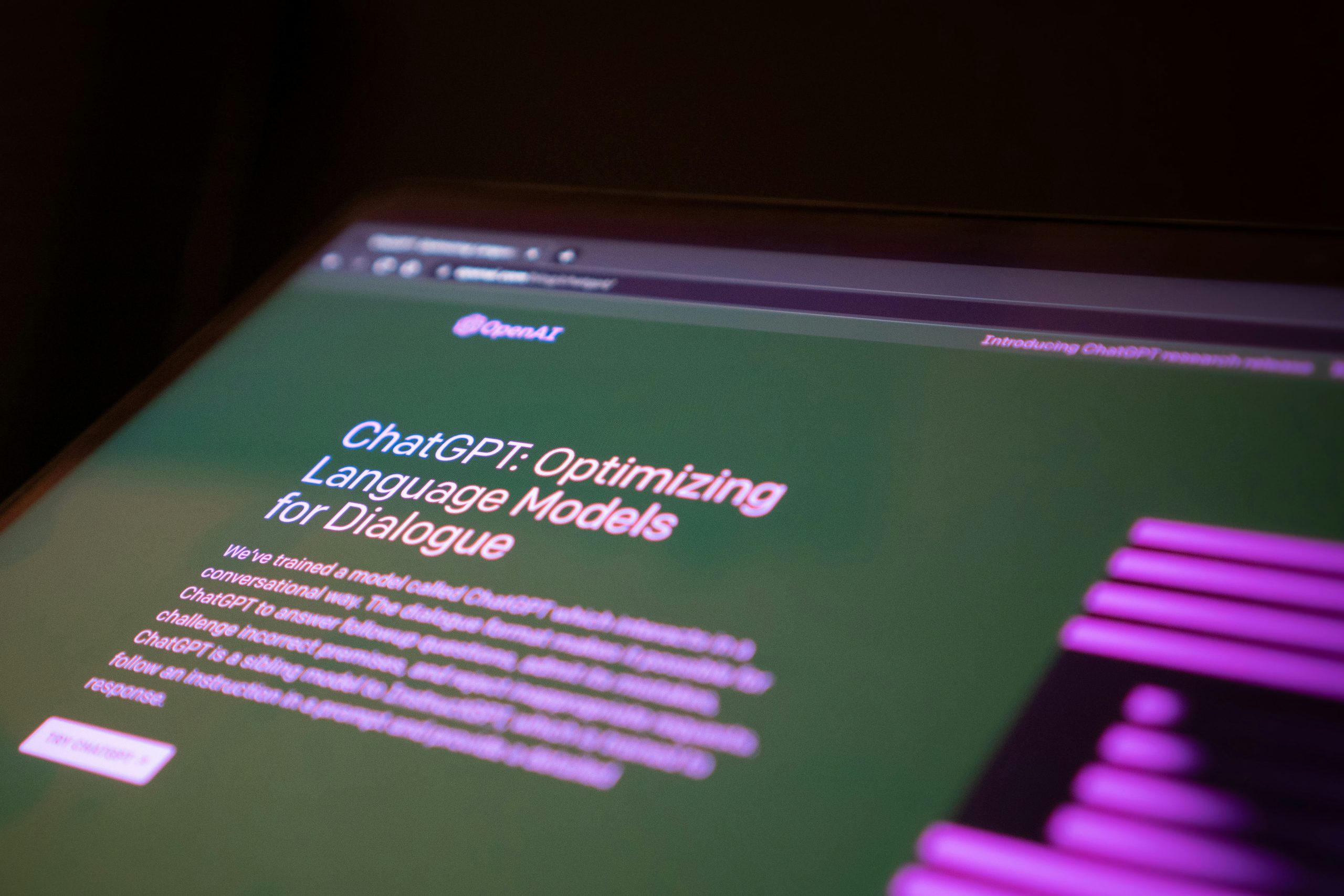How can we make sure that the future for computational scientists is sustainable, ethical, and successful? Photo Credit: Jonathan Kemper via Unsplash
Many technological developments constituting the emergence of the modern age can be traced back to advancements in the computational sciences (CSs), an umbrella-term spanning mathematics, statistics, computer science, and engineering. Such domains present the opportunity to make crucial breakthroughs with societal impact, be it the invention of the radio, the internet, or the large language model (LLM). Whilst CS research attracts swathes of intelligent and conscientious young people eager to make their mark, the demand for such minds is not restricted to scientific institutions but extends to the private sector. Financial institutions have long focused on mathematicians to guide their investment and speculation activities, using models and increasingly large datasets to find new opportunities for profit. More recently, social media giants have become some of the largest employers of CS graduates. As the lucrative compensation offered by these roles increases, so does the implicit cost of opting for career in academic research.
Opting for a career in CS research has always come with a troubling opportunity cost. On one hand, a new graduate can embark on a career in industry, sacrificing their academic freedom and often their work-life balance, or they can pursue academic research, conceding the more lucrative career to follow their interests more freely. However, the current artificial intelligence (AI) boom has complicated this classic trade-off by presenting a new, third option. The disproportionate prominence and wealth of a few behemoth tech companies alongside start-up culture and AI improvements, has led to a perfect storm that has bolstered the development of industry research labs. Companies such as Google, Meta, OpenAI, and Microsoft have spent billions of dollars in the field of theoretical and applied machine learning (ML) as part of the ‘AI arms race’. Such companies have begun to attract top CS researchers from academia with the promise of high-paying roles, in order to perform and publish scientific research. This development seemingly allows researchers to both “have their cake and eat it”, eroding the traditional opportunity costs of abandoning research for industry. Nevertheless, it brings with it new challenges that neither researchers, universities, nor societies are equipped to handle.
…a new graduate can embark on a career in industry, sacrificing their academic freedom and often their work-life balance, or they can pursue academic research, conceding the more lucrative career to follow their interests more freely.
Following his invention of the telephone, Alexander Graham Bell established a company that would go on to dominate American telecommunications, now known as AT&T. Over the 20th century, the research and development (R&D) arm of this all-American enterprise became a unique pillar of scientific research, fostering some of the most important innovations of the century, such as invention of the transistor and information theory. The storied Bell Labs was unparalleled as a research lab based in industry that could compete with the top scientific institutions of the Ivy League and beyond, ultimately culminating in nine Nobel Prize awards. Nevertheless, Bell Labs remained a curious anomaly until very recently, when ground-breaking research in AI began to emerge from the R&D arms of well-known tech giants. For example, DeepMind, the ML research wing of Google, recently published solutions to long-standing problems in both science and maths, including prediction of protein structures and improvements on mathematical algorithms. The opportunity to work on world-leading research without the confines of academic institutions has placed such labs amongst the most attractive destinations for young CS researchers. However, this new development is not free of its own costs and criticism. Analysis of the Computing Research Association’s (CRA) annual ‘Taulbee Survey’ highlights two worrisome trends in outcomes for CS researchers:

Fig 1. Analysis of CRA Taulbee Surveys from 2002-2022. Left: The vast majority of new AI PhDs enter industry over academia. Right: Since the early 2010s, more CS PhD students are opting to research AI instead of other fields. Data represents survey respondents from PhD awarding universities in North America and is available at CRA Taulbee Survey 2002-2022.
The so-called ‘AI summer’, that began in the early 2010s with developments such as ImageNet, prompted a surge in new AI PhDs, effectively draining other fields in CS of skilled and budding researchers. Concurrently, new PhD graduates appear to be abandoning academic roles with over 70% of AI PhDs in 2022 entering industry.
...many AI start-ups have begun to emerge, each with bold promises of revolutionising different aspects of society.
As AI has taken the market by storm, many AI start-ups have begun to emerge, each with bold promises of revolutionising different aspects of society. Nevertheless, the tech-giants Google, Microsoft, and Meta maintain an oligopoly on both US and global markets, still dominating the cutting-edge of AI research. This effect is due to both the extreme computational and personnel costs associated with such research, and the competitive, predatory acquisition strategies employed by “big tech”. Given the unprecedented potential that AI holds, it can appear worrying that so much research and talent is controlled by a few private companies. In fact, criticism of the oligopoly in tech is not new, and many have raised concerns surrounding the over-reliance of the global economy on a handful of companies. Analysis of the top 10 companies publishing AI research shows that the usual suspects such as Google and Microsoft are the most prolific, but also reveals an emerging race for dominance between the US and China, with 3 of the top 10 firms being based in China, and the rest in the US (Fig. 2).
criticism of the oligopoly in tech is not new, and many have raised concerns surrounding the over-reliance of the global economy on a handful of companies.

Fig 2. Top 10 private companies publishing research in AI. Analysis of the top 10 private companies publishing research in AI reveals an emerging race between the US and China. Data from PARAT, Emerging Technology Observatory (accessed 10th August, 2024).
Beijing’s development plan has promised to make China the global AI leader by 2030; a worrying scenario for the US and its allies. The importance of winning the AI arms race has been leveraged by US tech giants to combat possible restrictive policies or safety regulations, despite pleas for caution. As “big tech” continues to siphon top researchers away from public institutions and universities, their publishing and business models have also come under greater scrutiny. For example, DeepMind’s recent program called ‘AlphaFold3’, which is their latest protein-structure prediction algorithm, was released without publication of the accompanying code; traditionally a requirement. In this unprecedented case, both DeepMind and Nature came under fire, in particular from scientists who raised concerns about reproducibility and the fact that the model was trained on data collected using public funds. Similarly, OpenAI — originally founded as a non-profit — recently reorganised with the addition of a for-profit scheme. Additionally, they have received criticism for refusing to publish the model-details for the famed ChatGPT.
As AI improves in leaps and bounds, its impact on our lives will only become more noticeable. Whilst it is imperative that we get AI right, both being built safely and soon, there are pressing challenges in CS that cannot be neglected on our quest to building super-intelligence. Issues such as climate modelling, next-generation sequencing, neurotechnology, and quantum computing, to name a few, remain challenges with the potential for enormous impact in the coming decades. For those still driven to build the next generation of ML models, the question of how and where to build a career has become pressing. In a domain increasingly dominated by billionaire tech moguls, a commitment to open and safe science that benefits society has never been more important. If we cannot rely on regulators or governments to take the lead, the decision will fall squarely on the shoulders of the scientists at the heart of the matter. It is worth asking not only what you want to build, but also who you want to build it for.





